




March 2003
Destination: Manila
 Intramuros:
Intramuros:
City of History
by Juan Miguel de Leon
Okay, let's admit it. When asked about their potential tourist destinations, Filipinos tend to look away from the local cities and are eager to go to the provinces instead. Such exotic places as Sagada, Tubbataha and Anilao come to mind. One might say that the chances of a Filipino even mentioning Philippine provinces to go to for sightseeing are slim at best. Instead, such a Filipino would elect to go to other shores for his/her fix of culture and keepsake pictures.Before packing your bags and buying your travel tickets, though, why not consider staying in Manila for a while and checking out its own notable tourist destinations? The Department of Tourism is in the middle of a large-scale effort to promote the City of Manila as a big tourist site, and for local sightseeing, Intramuros, the famous walled city of the Spanish era, now offers most of Manila's most notable spots.
Manila Cathedral
Gen. Luna St.
This 16th-century cathedral has been torn down by earthquakes and wars, but is also constantly rebuilt afterwards. Its last reconstruction was after World War II. Today it is a favorite setting for nuptials.
Clamshells I and II
Anda cor. Arzobispo Sts. What might be considered as the Department of Tourism's biggest project in Intramuros, the big white Clamshell Tents showcase all the different Philippine regions' crafts and artwork.
What might be considered as the Department of Tourism's biggest project in Intramuros, the big white Clamshell Tents showcase all the different Philippine regions' crafts and artwork.
For the month of February 2003, the Department of Tourism has prepared an extensive program to show the best of the Southern Tagalog region, with a very wide variety of activities such as the crafts demonstrations of weaving, finger-painting and woodcarving. The department touts that by encasing the best of Southern Tagalog in Intramuros, "now you don't have to travel to enjoy a provincial tour." For those interested in traveling to Region IV, however, local tour agencies are on hand.
On the day of the visit, students from the nearby Colegio de San Juan de Letran were present for a field trip to Clamshell Tent I, proving the educational benefit of the Clamshell Tents and their activities as well.
Admission is free.
San Agustin Church and Museum
Gen. Luna cor. Real Sts.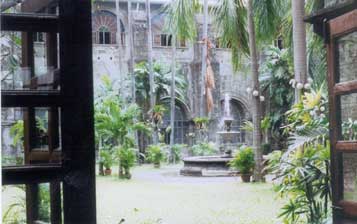 Another church within Intramuros, the San Agustin Church and Museum is 400 years old. Care has been taken after World War II to divert heavy trucks away from the vicinity of the church, as their harsh vibrations seriously affected the church's foundations.The museum showcases many historical and religious relics brought in by the Spaniards during their colonization of the Philippines. Various paintings and statues of saints are showcased here, as well as the evolving religious vestments of Spain and the Philippines. The adjoining gardens of the church are a wonder to behold as well.During my visit, an Anne Frank exhibit was also up for display, as with copies of the book "Anne Frank: A History for Today" being sold at the tourist counter.
Camera buffs will be pleased to know that this is a site that welcomes picture-taking for some of its sections, although as in many European churches, flash photography is strictly forbidden.
Another church within Intramuros, the San Agustin Church and Museum is 400 years old. Care has been taken after World War II to divert heavy trucks away from the vicinity of the church, as their harsh vibrations seriously affected the church's foundations.The museum showcases many historical and religious relics brought in by the Spaniards during their colonization of the Philippines. Various paintings and statues of saints are showcased here, as well as the evolving religious vestments of Spain and the Philippines. The adjoining gardens of the church are a wonder to behold as well.During my visit, an Anne Frank exhibit was also up for display, as with copies of the book "Anne Frank: A History for Today" being sold at the tourist counter.
Camera buffs will be pleased to know that this is a site that welcomes picture-taking for some of its sections, although as in many European churches, flash photography is strictly forbidden.
Casa Manila
Plaza San Luis Complex, Gen. Luna cor. Real Sts. A great place for casual history buffs, entering Casa Manila is bound to give tourists a ticket back in time. This is a replica of a genuine 19th-century Filipino residence before the arrival of the Americans on the archipelago, fully maintained by the government-run Intramuros Administration since 1979. It is touted as a "colonial lifestyle" museum, built in keeping with traditional Spanish-era architecture and engineering. For instance, the lower walls are made of adobe or volcanic tuff, while an 1850s Calle Jaboneros residence in San Nicolas inspires the facade of the modern-day Casa Manila.
The rooms are completely furnished with period furniture, curios and tools, such as old hardbound Spanish bibles, coal-heated irons, an Indian hand-operated ceiling fan, and a cement dome of a bread oven. Although it shares the bottom entrance with the rest of the commercial/cultural Plaza San Luis complex (also housing the restaurant Barbara's and Hotel Intramuros), it is in no way less fascinating than the interior.Tickets are priced at PhP50 for adults and PhP15 for students with ID. A bit of a caveat: Pictures are sadly not allowed inside Casa Manila.
A great place for casual history buffs, entering Casa Manila is bound to give tourists a ticket back in time. This is a replica of a genuine 19th-century Filipino residence before the arrival of the Americans on the archipelago, fully maintained by the government-run Intramuros Administration since 1979. It is touted as a "colonial lifestyle" museum, built in keeping with traditional Spanish-era architecture and engineering. For instance, the lower walls are made of adobe or volcanic tuff, while an 1850s Calle Jaboneros residence in San Nicolas inspires the facade of the modern-day Casa Manila.
The rooms are completely furnished with period furniture, curios and tools, such as old hardbound Spanish bibles, coal-heated irons, an Indian hand-operated ceiling fan, and a cement dome of a bread oven. Although it shares the bottom entrance with the rest of the commercial/cultural Plaza San Luis complex (also housing the restaurant Barbara's and Hotel Intramuros), it is in no way less fascinating than the interior.Tickets are priced at PhP50 for adults and PhP15 for students with ID. A bit of a caveat: Pictures are sadly not allowed inside Casa Manila.
Fort Santiago and Rizal Shrine
Gen. Luna St.
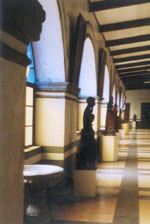 Simply put, a tour of Intramuros would not be complete without Fort Santiago. This was the Spaniards' once-mighty military headquarters, decorated by the wooden relief of Spain's patron saint James, Slayer of Moors (Santiago Matamoros), hence the name.Although the fort has had its gloomy history, as a dreaded barracks and prison of the Spanish and torture den of the Japanese, it was destroyed by the Americans in 1945 and was restored in 1950 after its declaration as a "shrine of freedom" by Congress. This is also where national hero Dr. Jose Rizal spent his final days before execution by firing squad.The old adobe barracks has been converted to the Dulaang Rajah Soliman, a small theater, and to the left side is Rizal's old chapel-cell. An old reducto has been converted to the Shrine of Our Lady of Guadalupe, as well.
Inside Rizal Shrine-also an old brick barracks-are the doctor's manuscripts of his novels Noli Me Tangere ("Touch Me Not") and El Filibusterismo ("Subversion"), as well as his tools, clothing and other curios like the Rizaliana Furniture Exhibit.
Simply put, a tour of Intramuros would not be complete without Fort Santiago. This was the Spaniards' once-mighty military headquarters, decorated by the wooden relief of Spain's patron saint James, Slayer of Moors (Santiago Matamoros), hence the name.Although the fort has had its gloomy history, as a dreaded barracks and prison of the Spanish and torture den of the Japanese, it was destroyed by the Americans in 1945 and was restored in 1950 after its declaration as a "shrine of freedom" by Congress. This is also where national hero Dr. Jose Rizal spent his final days before execution by firing squad.The old adobe barracks has been converted to the Dulaang Rajah Soliman, a small theater, and to the left side is Rizal's old chapel-cell. An old reducto has been converted to the Shrine of Our Lady of Guadalupe, as well.
Inside Rizal Shrine-also an old brick barracks-are the doctor's manuscripts of his novels Noli Me Tangere ("Touch Me Not") and El Filibusterismo ("Subversion"), as well as his tools, clothing and other curios like the Rizaliana Furniture Exhibit.
Kultýr Magazine, Inc.
Questions? Contact the Webmaster







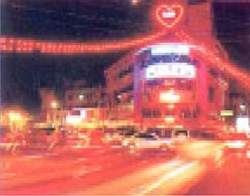 Malate offers a unique blend of music and relaxation. It has evolved into a new phase: fine dining and lounging.
Malate offers a unique blend of music and relaxation. It has evolved into a new phase: fine dining and lounging.  If California has San Francisco as its "Art Hub", then the Philippines has Manila as its center for culture and arts.
If California has San Francisco as its "Art Hub", then the Philippines has Manila as its center for culture and arts. 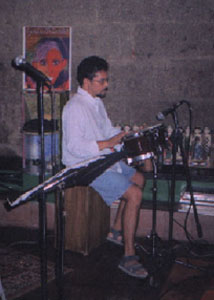 Long have I wandered the streets of Manila in search for a place of comfort, long have I wandered the streets of Manila in search for a place of refuge.
Long have I wandered the streets of Manila in search for a place of comfort, long have I wandered the streets of Manila in search for a place of refuge. 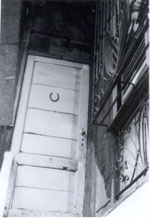 A long long time ago, before World War II, or urban development, two buildings stood in quiet majesty along a narrow kalye behind the University of Santo Tomas.
A long long time ago, before World War II, or urban development, two buildings stood in quiet majesty along a narrow kalye behind the University of Santo Tomas.